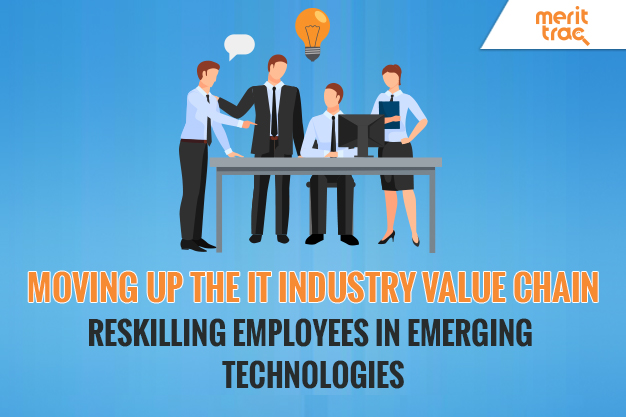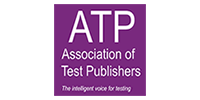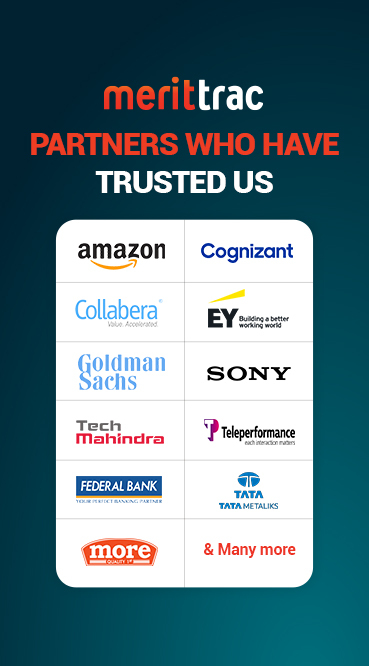
Moving up the IT Industry Value Chain: Reskilling Employees in Emerging Technologies
Date: 10/05/2019 | Posted by: MeritTrac | Category: Corporate , Workforce Development
With half of its population under the age of 25 years and two-thirds under 35 years, India is poised to become the largest workforce in the world by 2027. While these figures point to a big advantage, they also reflect a major challenge. US$ 1.97 trillion in GDP growth is at risk over the next decade due to a severe gap in relevant skills. According to Accenture’s Fueling India’s Skill (R)evolution report, only 20% of technical graduates are considered job-ready for the IT and ITES sector due to lack of relevant skills in emerging technologies such as data analytics, cloud, IoT and AI. Educational institutions still need to migrate from their traditional curriculum to the one that is in sync with the industry needs. While the Skill India initiative aims to skill 500 million Indians by 2022, it is not enough to close the gap. The role of government will have to expand to strategizing the distribution of niche AI and ML talent for the industry as well as institutions. Industry players will need to get in on the act to ensure that they build the right capabilities and expertise in their employees to address the growing demand for complex, problem solving roles.
Employee Value Chain
An employee value chain focuses on improving the value of an organization’s employees by using an entire gamut of tools and processes. Employee value proposition or EVP refers to the benefits or tools an organization offers to its employees to produce the best outcomes at work and to attract prospective employees. This may include recruitment, learning and development, career growth, pay and benefits, employee engagement, employee retention, and more. The concept of EVP has gained prominence due to the highly competitive war for talent. Employee value proposition helps organizations to be better prepared for driving employee engagement and build a positive brand image of the organization in the eyes of former, current, and future employees.
When the organization truly understands what the employee’s value the most and when their ideas, thoughts, or ambitions are thoughtfully included in the employee value chain, it will help develop trust and bring about a sense of belonging to the organization. The skills and experiences the employees bring to the organization, thus helping achieve the key business metrics, including improving customer engagement.
IT Industry Value Chain
The value chain of the IT services industry features Information technology outsourcing, KPO, BPO, and other industry-specific activities. Information technology outsourcing includes (from high to low) software R & D, IT consulting, software (ERP, applications development, applications integration, desktop management), and infrastructure (applications management, network management, and infrastructure management). Out of these, the Indian IT outsourcing services focus mainly on software development and infrastructure management, which are considered to be low-end services in the IT industry value chain. However, the focus is now shifting to high-end services such as IT-consulting and software R&D, which are areas dominated by Global IT service providers.
Moving up the value chain with IT reskilling
According to Gartner’s 2016 Planning Guide for Professional Effectiveness, the optimal profile of an IT worker in today’s digital enterprises is “T-Shaped”. The T-shape indicates both depth of expertise in one or more technical disciplines as well as the breadth to understand, innovate and effectively communicate for enhanced productivity and customer satisfaction. Tech firms are therefore increasingly redefining their job profiles even as they are embedding new technologies into their processes. They are drawing up new skill archetypes for the new-age roles so they can align the skills of their employees with the latest job requirements. But to achieve this alignment, they must first identify the gap between their employees’ current skill level and what is required for the evolving roles. This is why companies are turning to assessment firms to test candidates for specific skills such as coding. Once the skill gaps are identified, it becomes easy to implement learning and development programs that can address the reskilling needs of potential employees. Reskilling existing employees is a much more effective strategy compared to hiring new employees as it would incur additional costs and training hours. With the right training for IT reskilling, Indian IT organizations can successfully move up the value chain and establish themselves as high-end service providers.
Assess employees’ skills using cognitive and domain assessments to identify gaps
At a time when companies plan to pay 20% above the market for quality engineering talent, testing the candidates more accurately using scientific methods is critical. These scientific tests equip employers to assess their employees on the basis of cognitive as well as domain-related skills to pinpoint the exact skill gap and build a focused strategy to bridge that gap.
Empower employees with high quality courses to close the gaps
Indian IT firms are realizing the many benefits of upskilling and reskilling employees instead of hiring more employees. Providing skilling opportunities to employees not only cuts down on hiring costs and time lag in bridging the skill gap, but also improves the employer brand. Several Indian IT companies are relying on MOOCs (massive online open courses) to reskill their employees and sustain their employability. Industry leaders such as Wipro, Tech Mahindra and Mindtree are working with online training platforms to tailor specific learning programs for their employees. In another leading example, as a part of its Skills to Succeed (S2S) project, Accenture uses a tech-enabled learning platform that combines digital learning tools with a traditional classroom model.
Continuously track and evaluate upskilling/reskilling requirements on an ongoing basis
Companies recognize the need to be agile to stay ahead of the competition in today’s volatile markets. In order to build an effective solution to address the skill gap issue, futuristic IT firms take a proactive approach and track their upskilling/reskilling requirements on a consistent basis. They realize that reskilling is not a one-time fix as innovative technologies are constantly disrupting industrial processes and market behaviors. To this end, IBM set up its ‘Career Transition Center’ to enable its employees to visualize their career trajectory in a more dynamic context. The concept of the center is based on increasing the employability of their employees by assisting them in analyzing their own skill level.
Conclusion
Pioneering tech companies are viewing India’s skill challenge not so much as a stumbling block but rather as a business opportunity to drive growth. They are implementing effective employability skills assessment, training and reskilling models, empowering their workforce to harness emerging technologies for growth and customer satisfaction. At MeritTrac, we offer a suite of workforce development assessment solutions that facilitate the reskilling of employees through streamlined training and development programs. Now you can quickly identify top-performing employees, improve employee engagement, and conduct thorough employee succession planning with MeritTrac.
Sources:
- accenture.com
- livemint.com
- trainingindustry.com
- rediff.com
- morningfuture.com













 Sales Hotline: USA: +1 646 916 0939 / Others: +91 80619 14700
Sales Hotline: USA: +1 646 916 0939 / Others: +91 80619 14700


